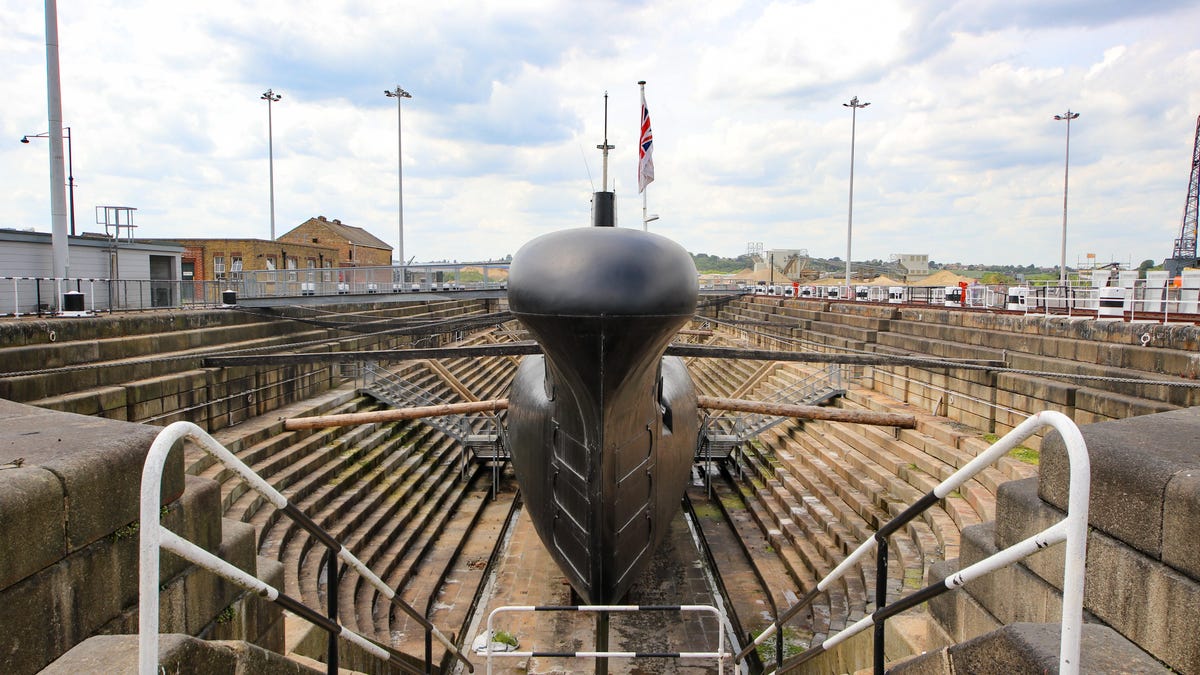
Ocelot!
Here's a look at Her Majesty's Submarine Ocelot, which was launched in 1962 and served for 29 years.
You can read more about this tour in Silence in the deep: A look inside the HMS Ocelot.
Sail
Like all diesel-electric subs, in addition to periscopes, there are air intake and exhaust snorkels for the engines, when running.
Propless
The propeller is gone, but in its day the sub had a top speed of 20mph/31kph when submerged, and 14mph/22kph on the surface.
Big nose
The bulbous bow houses sonar equipment.
Torpedoes...
Up front were 6 torpedo tubes. Initially, there were two more in the back, but these were later removed.
... away
The Ocelot helped contribute to the testing and development of the Royal Navy's Mk 24 Tigerfish torpedo.
Escape trunk
In case of emergency, this compartment would be used as a staging area for escape, through this small hatch. In the dark. Wearing bulky survival gear.
Survival gear
Said survival gear, along with the respirator that would be plugged into emergency air tubes that ran along the ceiling.
Not-so-tasty treats
To give the men a burst of energy while waiting potentially hours for their turn to escape, inside these cabinets were rations of barley sugar candy. Apparently they tasted terrible, perhaps as a preventative measure to ward off snacking sailors.
Fully loaded
The Ocelot could carry up to 24 torpedoes, most of which would be stored in here. You enter through the torpedo loading hatch.
No hot bunking
Eventually every sailor would get their own bunk, but that isn't always the case in older subs.
Every day, every night
If you weren't on shift, you were probably in your bunk or in one of these areas. The Ocelot had 7 officers, who had their own areas, and 62 enlisted men, who had bunks all over the ship.
Space
I've toured a lot of subs, and for one of this era, the Ocelot/Oberon-class had a relatively large amount of space dedicated for the crew.
Uniforms
Apparently the dress uniforms were strictly for formal events. Once a sailor was on board, it'd go under his bunk to stay "pressed." He would default to shorts and a t-shirt.
Officers
As with all navy vessels, the officer's accommodations are a little nicer.
Captain's quarters
The captain would get his own room, such as it was.
Too tall
The last captain of the Ocelot was apparently over 6 feet, and couldn't fit in his bunk. The crew cut a hole in the bulkhead so his feet could slide through.
The room where it happens
Were the serious work was done. What that serious work was, we still don't know. Most is still classified.
Knobs and levers
I'm sure not an inconsequential amount of training is involved to learn what all this does.
Dive!
The driver sits on the left? How surprisingly un-British.
Rigged for red
Nighttime aboard the Ocelot, as demonstrated by the wonderfully knowledgeable docent Theresa.
Tubes
I'd be curious how much of this has changed on modern subs. There will be more wires for sure, but there are some things that just need a good old fashioned valve.
Comms
Some of the Cold War era electronics gear. You can see the edge of some headphones on the right.
Showers... sometimes
69 men in tight quarters with limited showers and only one, maybe two, changes of clothes. Good thing diesel fuel is pungent.
Galley
It is said that submariners are the best feed in the fleet. A small mercy considering they're without daylight for days and weeks on end.
More dials
The engine room has, as you'd expect, a plethora of beautiful dials. Why yes, I'm into steampunk, how'd you guess?
Generators
This panel keeps track of a number of things, including the desalinator for fresh water, and what the main generators are doing. The blue label says "Void spaces and gear boxes to be cleaned each watch."
V-16
The Ocelot had two 1,840hp V-16 diesel engines that were reportedly so smooth running you could balance a coin on it's side while they were running.
Engine room
While the diesel engines can drive the propellers directly on O-class subs, typically they power generators to recharge the batteries. That all gets directed from here.
Engineering crew
Logically, if your job was in the back half of the boat, you bunked in the back half of the boat.
Torpedoes no more
Originally there were two more torpedo tubes back here, but they were removed in the latter half of the Ocelot's service life.
Clandestine activities
For the most part, more storage. Plus equipment for... secret things perhaps? You can see the sealed-up tubes on the far bulkhead. The BBC has a great article interviewing some of the former crew.
Under, around and through
It's rare that you can go under a submarine, but here you can, with all 1,600 tons right above your head.
Drydock
The Ocelot is now in drydock, to keep her preserved as long as possible. You can tour her yourself at the Chatham Historical Dockyard.
You can read more about this tour in Silence in the deep: Inside the HMS Ocelot stealth submarine.

